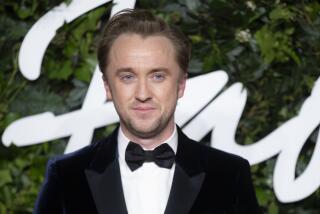From the Archives: ‘Harry Potter and the Half-Blood Prince’ is well-crafted but sometimes hard to endure
Today marks the 20th anniversary of the first book in J.K. Rowling’s Harry Potter series. From our archives, we’re resurfacing The Times’ original reviews of each Harry Potter film adaptation. The following review of “Harry Potter and the HalfBlood Prince” was first published July 14, 2009.
“Harry Potter and the Half-Blood Prince” is being described as an excursion into the dark side for this venerable series, but don’t let the chatter fool you. Now in its sixth episode shot over an eight-year span, with two more features still to come, this one-of-a-kind film cycle has become as comfortable and reliable as an old shoe, providing a degree of dependability that’s becoming increasingly rare.
As directed by David Yates, who did the previous film and is on tap for the final two, “Half-Blood Prince” demonstrates the ways that the Potter pictures have become the modern exemplars of establishment moviemaking. We don’t turn to these films for thrilling or original cinema, we look for a level of craft, consistency and, most of all, fidelity to the originals -- all of which we get.
Yes, the Death Eaters in thrall to Lord Voldemort, “the most dangerous dark wizard of all time,” are on the march and threatening Hogwarts and all it stands for, but those who’ve read the books know how all that plays out. It’s not chills or suspense audiences are asking for here, but respectful familiarity.
It’s only the phenomenal success of the books that has made all this possible, that has ensured a loyal audience for each film, an audience that has invested so much emotion, not to mention time, in the ongoing Potter saga that skipping an episode is out of the question. That’s a kind of brand loyalty that’s all but gone out of style.
MORE: Every ‘Harry Potter’ movie review »

To mark the 20th anniversary of the first book’s release, Rowling took to her Twitter account to write, “20 years ago today a world that I had lived in alone was suddenly open to others. It’s been wonderful. Thank you.” (June 26, 2017) (Sign up for
That investment of time also means we’ve been watching the film’s trio of youthful principals -- Daniel Radcliffe as Harry, Rupert Grint as sidekick Ron Weasley and Emma Watson as brainy Hermione Granger -- grow up on screen since 2001. They’ve become as familiar as family members, and “Half-Blood Prince” trades on that connection to keep us involved when things get slow.
This bond is especially necessary in those sections of the film in which the Hogwarts gang goes through the agonies of teenage romantic attachment. Is Harry getting serious about Ginny Weasley (Bonnie Wright)? Will Ron be too busy with Lavender Brown (Jessie Cave) to care? Or to so much as notice that his pal Hermione is pining away just for him? It’s not clear who suffers more here, the kids navigating this “High School Confidential” universe or audiences having to endure it with them.
Fortunately, there’s more to “Half-Blood Prince” than youthful heartache. Evildoers like Bellatrix Lestrange (Helena Bonham Carter) and young Draco Malfoy (Tom Felton) scheme dark schemes, and though Voldemort doesn’t appear as an adult, the film has a pair of memory flashbacks in which we see him as Tom Riddle, the evilest boy who ever was.
As for Harry, he has serious tasks of his own to attend to. He has to help recruit faculty member Horace Slughorn (Jim Broadbent), deal with an old textbook powerfully annotated by the mysterious Half-Blood Prince, and rise to the occasion when Professor Dumbledore (Michael Gambon) ups the ante and says to him, “Once again I must ask too much of you.”
The addition of the excellent Broadbent to a cast that includes, besides Gambon and Bonham Carter, such fine British performers as Maggie Smith, Robbie Coltrane and David Thewlis, underlines the Potter films’ ongoing status as a comprehensive guide to contemporary U.K. acting. First among equals in “Half-Blood Prince” is Alan Rickman as the monumentally unpleasant Professor Severus Snape, dripping disdain when he eviscerates Harry with lines like, “How grand it must be to be the chosen one.”
Also helping keep things professional are screenwriter Steve Kloves, returning after taking the last film off, and director Yates. A veteran of British TV responsible for such highly respected fare as the original miniseries version of “State of Play,” Yates in his second Potter film seems more comfortable with the franchise. He’s turned out to be what the series has always felt it needed, a good steward of the material who is respectful of the novels but not overly reverential.
As they head toward the closing episodes -- Part 1 of “Harry Potter and the Deathly Hallows” will come out in 2010, Part 2 in 2011 -- it becomes clearer and clearer that these films are a law unto themselves: cozy tales told around a cinematic campfire that have managed to reach out to the world.
--
‘Harry Potter and the Half-Blood Prince’
MPAA rating: PG for scary images, some violence, language and mild sensuality
Running time: 2 hours, 33 minutes
More “Harry Potter” film reviews from the archives:
‘Harry Potter and the Deathly Hallows — Part 1’ delivers more of the same for series fans
‘Harry Potter’ prequel ‘Fantastic Beasts and Where to Find Them’ casts a faltering spell
More to Read
Only good movies
Get the Indie Focus newsletter, Mark Olsen's weekly guide to the world of cinema.
You may occasionally receive promotional content from the Los Angeles Times.











